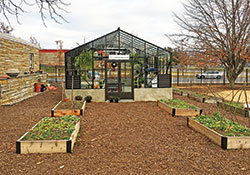2018 Catholic Schools Week Supplement
Students ‘dig’ discovering new ways to see the world

Raised garden beds near the new outdoor learning lab at St. Bartholomew School in Columbus offer students an opportunity to study the growth of plants. (Submitted photo)
By Natalie Hoefer
The Thanksgiving feast at St. Bartholomew School in Columbus last year was particularly special: among the fare enjoyed by students and staff members was lettuce grown by the fifth-grade class at the school’s new outdoor learning lab, an area containing a permanent greenhouse nearly 25 feet by 17 feet in size built next to raised garden beds.
“We asked every grade level to plan a unit to use the outdoor learning lab to cover the science standards for their grade,” says principal Helen Heckman. “We brought together our science, math and technology teachers so they can better collaborate and look at STEM initiatives.”
St. Bartholomew middle school science teacher Bridget Steele gushes about the opportunities provided by the outdoor learning lab.
“All middle school students will complete the Junior Master Gardeners Program over the next two years and become certified,” she says. “[A] rocks and minerals dig site allows students to study the rock cycle while identifying rocks that they dig out themselves.”
The area also offers a worm farm
“where [students] learn about the importance of soil,” adds Steele.
Middle school students will collect temperature readings and collect data on decomposition rates to engineer the best composting system, and fourth graders will learn about the importance of native species and the interdependence of pollinators and flowering plants in the lab’s butterfly garden and monarch watch station.
Steele notes the importance of math in “evaluating data on growth measurements and other activities related to the greenhouse, but also on weather-related readings, data collection and graphing at our weather station.”
And the current integration of the new space into class curricula “is just the tip of the iceberg,” she says, noting that the outdoor learning lab is still in its first phase.
Steele is not the only one excited about the outdoor learning lab.
“We worked the dirt, then we planted the seeds row by row,” says fifth-grader Amelia Fay of her class’ lettuce project. “It was really cool and fun. It was very delicious when we cooked it.”
Third-grader Ella Campbell, who joined her classmates in testing how plants grow in various soils, thought it was “cool because we could see how [the plants] grew each day.”
The students’ enthusiasm proves a point for Steele: “Kids learn best from doing authentic and relevant projects.
“The motivation and depth of learning are just two wonderful outcomes of project-based STEM-related content. The Outdoor Learning Lab naturally connects our students to our community partners and real-world problems.
“Our students discover a love of learning, [and see that] digging in the dirt, sorting seeds, handling bees and worms—this stuff isn’t gross, boring or scary, but real and amazing.” †
